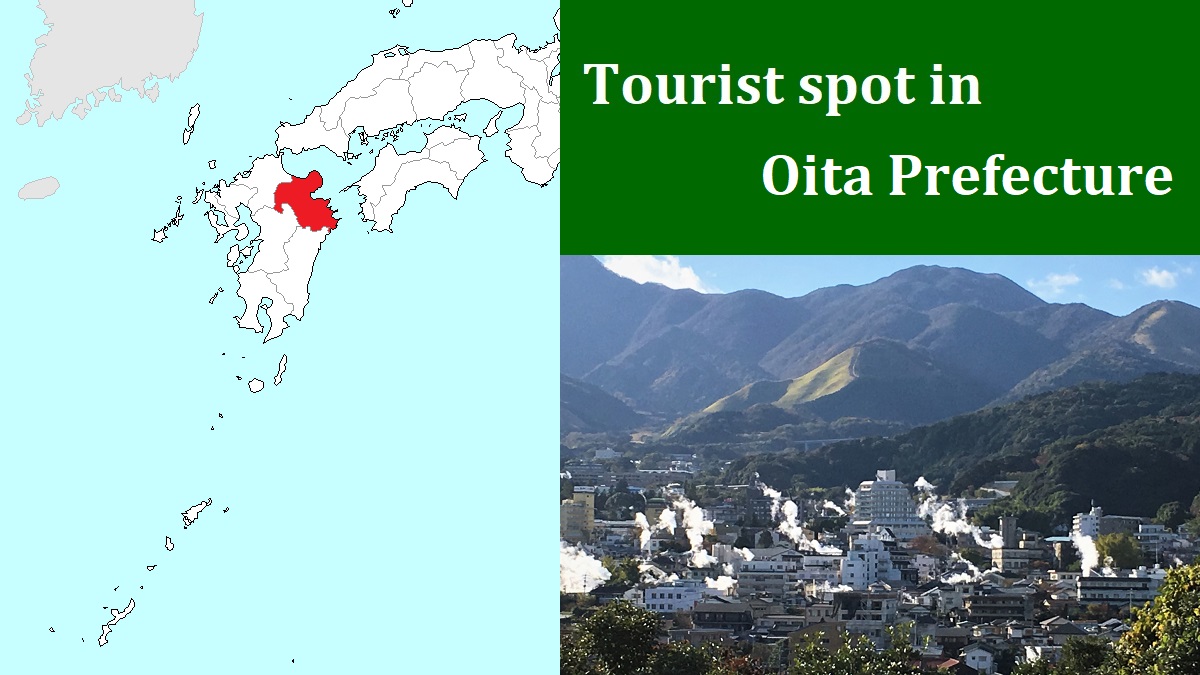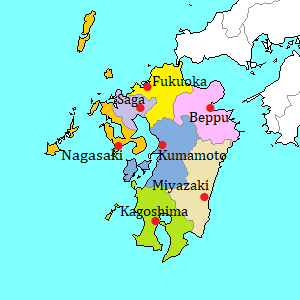Beppu city [別府]
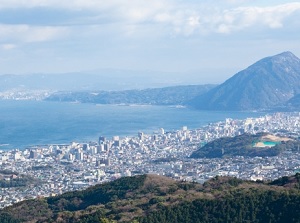
Beppu city
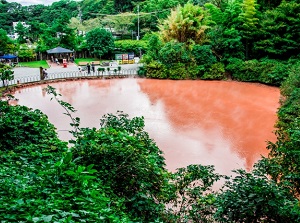
Chi-no-ike Jigoku in Beppu
Beppu is the second largest city in Oita Prefecture after Oita city.
The population is about 115,000.
It is located about 15 km west-northwest of Oita city, and the east coast faces Beppu Bay connecting to Seto Inland Sea.
There are two active volcanos to the west of this city.
They are Mount Tsurumi (1,375 m) and Mount Yufu (1,583 m).
Beppu is at the foot of the mountains, so there are many hot springs in the city.
On the western foot of Mount Yufu, there is popular Yufuin hot spring resort.
The number of hot spring wells in Beppu city is about 2,280, and accounts for half in the prefecture.
About 137 kiloliters of hot water is discharged from these wells in a day.
Therefore, we can see the rising steam of the hot spring in some places.
By the way, Beppu Ropeway is operated to the top of Mount Tsurumi from the foot.
Beppu Hattô (別府八湯)
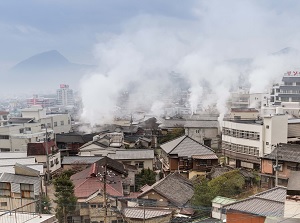
Steam in the onsen area in Beppu
Photo: Kyushu Tourism Promotion Organization
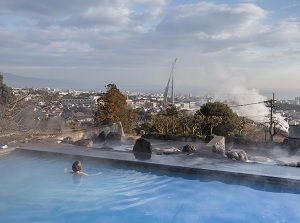
Outdoor bath in Kankaiji
Photo: Kyushu Tourism Promotion Organization
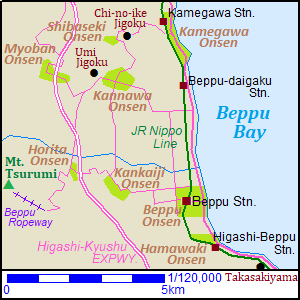
More than 250 hotels and ryokans are in this city.
These are dotted in the main eight areas.
The areas are called Beppu Hattô meaning "Eight hot spring resorts in Beppu".
Each of them has a different spring quality and atmosphare.
Beppu Onsen (別府温泉) is the central resort area around JR Beppu station.
Many ryokans, hotels and public bathhouses are in the downtown.
Hamawaki Onsen (浜脇温泉) is near the shore located about 1 km south of JR Beppu station, and there are only some small public bathhouses.
Kankaiji Onsen (観海寺温泉) is in the area on the slope of the mountain, and is located about 2.5 km west of JR Beppu station.
The accommodations have a good view of the city and the sea.
Horita Onsen (堀田温泉) is in the area about 2 km west of Kankaiji Onsen, and is just at the foot of Mount Tsurumi.
It is in a quiet area, and much hot water is discharged in Beppu.
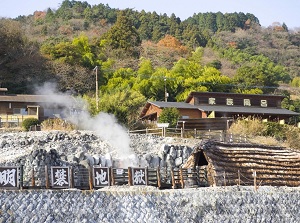
Myoban Onsen in Beppu
Photo: Kyushu Tourism Promotion Organization
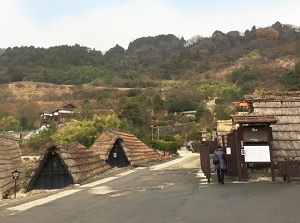
Huts to product alum in Myoban Onsen
Myôban Onsen (明礬温泉) is in the area on the moutainside located about 8 km northwest of JR Beppu station.
"Myôban" means "alum".
Literally, this area has produced alum since ancient times, and there area some huts to product alum.
The hot spring water includes alum and sulfur, so it has a color of milky white.
Kannawa Onsen (鉄輪温泉) is in the area to the east of Myôban Onsen and is located about 5 km north of central Beppu.
There are not only general hotels and ryokans but also many accommodations for long stay to cure disease.
There are the places that the steam of the hot spring is blown up, and they are used to steam food and warm the rooms.
Near this area, there are some places of "Hells of Beppu" to be mentioned later.
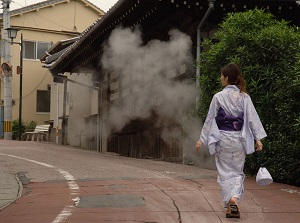
Kannawa Onsen in Beppu
Photo: Oita Prefectural Tourism Association
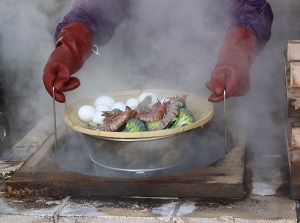
Steamed food in Kannawa Onsen
Photo: Kyushu Tourism Promotion Organization
Shibaseki Onsen (柴石温泉) is in the area located about 2 km north of Kannawa Onsen.
It is an old hot spring.
It is said that Emperor Daigo took the bath in 895 and Emperor Go-Reizei took it in 1044.
Kamegawa Onsen (亀川温泉) is in the area located about 7 km north of central Beppu.
It is on the seaside and there a few public bathhouses.
Hells of Beppu (別府の地獄)
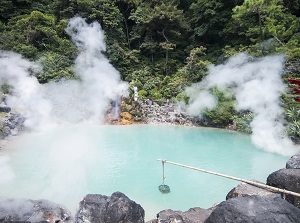
Umi Jigoku
Photo: Oita Prefectural Tourism Association
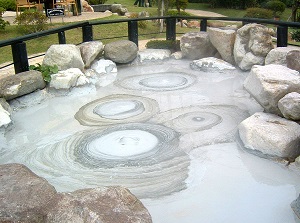
Oniishi-Bozu Jigoku
Photo: Oita Prefectural Tourism Association
The places discharging hot water from the earth show strange spectacle.
It evokes a scenery of hell.
So such spring or pond is sometimes called "jigoku" meaning "hell" in Japanese.
There are over a dozen spots of "jigoku" in Beppu city.
Particularly, seven of them are popular, and the regular sightseeing bus touring around them is operated from Beppu station.
Five of them are near Kannawa Onsen.
Umi Jigoku (海地獄, Hell of Sea) is a pond of hot water.
The color of water is cobalt blue by iron sulfate.
The color looks like sea, but the temperature of the water is 98 degrees C.
Oniishi-Bôzu Jigoku (鬼石坊主地獄, Hell of Priest's head) is a pond of mud, and is located about 350 meters from Umi Jigoku.
Oniishi is the name of the first owner of this pond.
Hot water springs up with white mud, and the place looks like a skin-head of Buddhist priest.
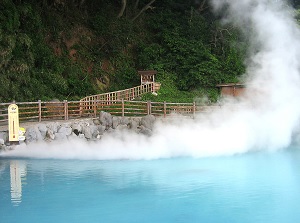
Kamado Jigoku
Photo: Oita Prefectural Tourism Association
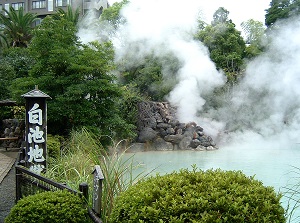
Shiraike Jigoku
Photo: Oita Prefectural Tourism Association
Kamado Jigoku (かまど地獄, Hell of Oven) is a pond that hot steam is blown up, and is located about 350 meters from Oniishi-Bôzu Jigoku.
When the annual festival of Kamado Hachimangu shrine is held, rice for the god is cooked using the hot steam of this jigoku.
Oniyama Jigoku (鬼山地獄, Hell of Damon's mountain) is a pond of hot water, and is near Kamado Jigoku.
The pond is filled with green hot water.
Crocodiles are bred using this hot water.
Shiraike Jigoku (白池地獄, Hell of White pond) is a pond of hot water in a Japanese garden, and is located about 150 meters from Oniyama Jigoku.
Clear hot water springs, but it becomes white when the temperature drops.

Chi-no-ike Jigoku
Photo: Kyushu Tourism Promotion Organization
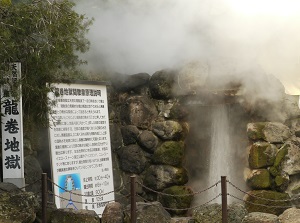
Tatsumaki Jigoku
Photo: Oita Prefectural Tourism Association
Two spots are near Shibaseki Onsen about 2 km north of Kannawa Onsen.
Chi-no-ike Jigoku (血の池地獄, Hell of Blood pond) is located to the east of Shibaseki Onsen, and is the most popular spot.
As its eerie name suggests, the color of water is red by oxidized iron.
Tatsumaki Jigoku (龍巻地獄, Hell of Tornado) is near Chi-no-ike Jigoku.
It is a geyser shooting boiling water every 20 to 40 minutes.
For the safety of tourists, walls and fences are set up around the spring.
How to get here
By JR limited express, about 1.5 hours from Kokura, about 2 hours and 10 to 30 minutes from Hakata.
From Oita, by JR Nippo Line, about 8 minutes by limited express, about 12 minites by local train.
From Oita Airport to Beppu, about 40 to 50 minutes by route bus.

